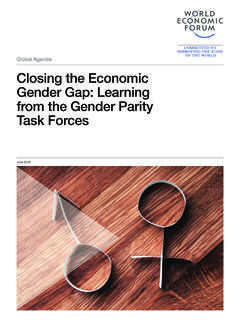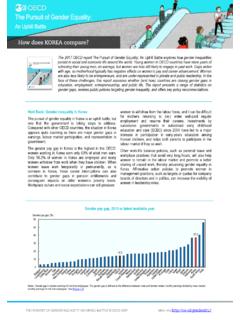Transcription of Closing the Gender Gap: Act Now - OECD.org
1 Closing the Gender Gap Act Now OECD 2012. Executive summary g ender equality is not just about economic empowerment. It is a moral imperative. It is about fairness and equity and includes many political, social and cultural dimensions. It is also a key factor in self-reported well-being and happiness across the world. Many countries worldwide have made significant progress towards Gender equality in education in recent decades. Girls today outperform boys in some areas of education and are less likely to drop out of school. But the glass is still only half full: women continue to earn less than men, are less likely to make it to the top of the career ladder, and are more likely to spend their final years in poverty. Gender inequality means not only foregoing the important contributions that women make to the economy, but also wasting years of investment in educating girls and young women.
2 Making the most of the talent pool ensures that men and women have an equal chance to contribute both at home and in the workplace, thereby enhancing their well-being and that of society. The economic case for Gender equality Greater educational attainment has accounted for about half of the economic growth in OECD. countries in the past 50 years and that owes a lot to bringing more girls to higher levels of education and achieving greater Gender equality in the number of years spent in education. Greater educational equality does not guarantee equality in the workplace, however. If high childcare costs mean that it is not economically worthwhile for women to work full-time;. if workplace culture penalises women for interrupting their careers to have children; and if women continue to bear the burden of unpaid household chores, childcare and looking after ageing parents, it will be difficult for them to realise their full potential in paid work.
3 In developing countries, if discriminatory social norms favour early marriage and limit women's access to credit, girls' significant gains in educational attainment may not lead to increased formal employment and entrepreneurship. The issues are complex and tackling them successfully means changing the way our societies and economies function. Men and women have to be able to find a work-life balance that suits them, regardless of family status or household income. Sharing childcare responsibilities can be difficult in a culture where men are considered professionally uncommitted if they take advantage of parental leave and mothers are sidetracked from career paths. And if good quality, affordable childcare is unavailable, it may simply be impossible for many parents, especially those on low incomes, to work full-time and take care of their families.
4 13. EXECUTIVE SUMMARY. Well thought-out policies can help, but further action needs to be carefully considered to be sure that future change is as positive for growth and social outcomes as increased educational attainment has proved to be. To that end, general economic, labour market and entrepreneurship policy reform may be required and the lack of comprehensive and reliable information in some key areas must be overcome. Increased Gender equality has at least as many, if not more, benefits to offer developing countries, where women's economic empowerment is a prerequisite for sustainable development, pro-poor growth, and the achievement of all the Millennium Development Goals (MDGs). Investment in Gender equality yields the highest returns of all development investments.
5 Education Although most countries around the world have won the battle to provide universal primary education, the picture is much more mixed in secondary and higher education. Furthermore, policy needs to keep a firm eye on ensuring continuous improvement in the quality of education. Girls are still less likely than boys to even start secondary education in Western, Eastern and Middle Africa and in South Asia. Enrolment is less of a problem in OECD countries, where education is generally compulsory up to the age of 15 or 16 years old. Boys, however, are more likely to drop out of secondary education, particularly in high-income countries. As a result, young women are increasingly better educated than young men in many OECD. countries. In reading skills, for example, boys lag behind girls at the end of compulsory education by the equivalent of a year's schooling on average.
6 They are also far less likely to spend time reading for pleasure. Boys do perform better in mathematics, but the Gender gap is narrower than in reading. Girls are still less likely to choose scientific and technological fields of study and, even when they do, they are less likely to take up careers in those fields a cause for concern given the skills shortages in the workplace, the generally more promising career and earnings prospects in science and technology, and the likelihood of positive spillover into innovation and growth. Educational aspirations are formed early in life in OECD countries, so one answer should be to focus more attention on changing Gender stereotypes and attitudes at a young age. Gender stereotyping frequently takes place in subtle ways at home, in schools, and in society.
7 If primary teachers are mainly women, and secondary teachers, particularly in the sciences, are predominantly men, what messages are boys and girls getting about adult life? And if text books give examples of female nurses and male engineers, if teachers themselves project their beliefs about girls' and boys' abilities in mathematics or reading, what attitude towards those subjects will children form? Changing Gender stereotypes in school is, however, only part of the equation: attitudes are also crucially determined by what happens at home. In developing countries, where poor families may not be able to afford to send all their children to school, boys may come first. When primary schooling is made free, girls'. attendance indeed rises. But the cost of education is not just a question of school fees.
8 There are items such as uniforms and school meals support in those areas can help get 14 Closing THE Gender GAP: ACT NOW OECD 2012. EXECUTIVE SUMMARY. girls into school and keep them there all the way through secondary education. And education is the gift that keeps on giving: girls who have had schooling become mothers who, in turn, place high value on education for their own daughters. To reap the highest economic and social return on education investment, therefore, it is important to find out just why there are Gender differences in attitudes towards reading and mathematics, then to discover ways to reverse the imbalance. In the developing world, however, the prime focus must still be on getting girls into school and keeping them there, while ensuring that the schools they attend and the transport there and back are safe and that suitable sanitary facilities are provided.
9 Employment The transition from education to paid work is a crucial moment which lays the foundation for many of the inequalities encountered throughout women's working lives. More women have entered the workforce in recent years, but often experience more difficulty than men in finding a first job, earn less than them, and are more likely to work part-time. Furthermore, the fields of study that young women and men choose perpetuate Gender segregation in the labour markets, with women under-represented in the business sector and concentrated in health, welfare, education, and administrative jobs. Such Gender differences exist to a large extent because women still bear the burden of the unpaid, but unavoidable, tasks of daily domestic life, such as childcare and housework.
10 In less developed countries, young women are more likely than young men to be neither in employment nor in education or training. When they do enter the labour market, there is more chance they will be confined to the most vulnerable jobs, frequently in the informal sector. But irrespective of family commitments, many women find it difficult to climb the career ladder. In fact, inequalities increase the higher up the pay scale they go. The result is that, while in OECD countries women earn on average 16% less than men, female top-earners are paid 21% less than their male counterparts. The so-called glass ceiling exists: women are disadvantaged when it comes to decision-making responsibilities and senior management positions; by the time they get to the boardroom, there is only one of them for every 10 men.













